|
Cruising
the Yangtze at night doesn't leave a lot of exciting things to see.
With the exception of some small villages and farming communities
there isn't anything to see. Occasionally, as we approached a bigger
city, we could see headlights from cars as they negotiated the passages
between the mountains and valleys, but we never actually saw any
cars. It was just darkness for the most part. The ship, however,
would light the shoreline in the direction we were traveling so
the helmsman could steer a steady course and not run aground. For
the most part our nights were spent quietly. Dinner followed by
a stroll or two around the deck, perhaps a stop at the lounge for
a drink and chat with some friends, and then it was back to the
room for a movie and a good night's rest. No, it wasn't that early,
but speaking of early ... another disadvantage of organized tours.
Most of the time you have to be up early in preparation for the
day's events. On the ship we were usually up by 6:15 or 6:30 a.m.
the latest to insure that we'd get breakfast. After breakfast we
were off the boat by 8:30 a.m. for the day's excursions to the Lesser
Three Gorges and, today, the city of Wanxian.
Wanxian
is a city of millions that you've probably never heard of. Many
cities in China have populations in the millions that we've never
heard of so that shouldn't be surprising. The purpose of our visit
was to get a firsthand view of a city soon to be flooded by the
rising dam waters of the Yangtze and the efforts the Chinese are
expending to resettle the population to higher ground. In Wanxian
we would also visit a museum and a local market.
|
|
|
|
|
|
|
|
|
|
|
|
|
|
|
|
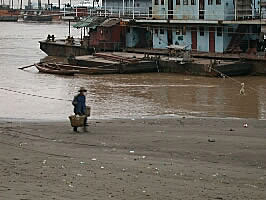 An
old man using an ancient Chinese
An
old man using an ancient Chinese
way of carrying heavy objects |
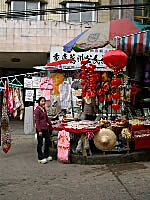 The
dollar people
The
dollar people |
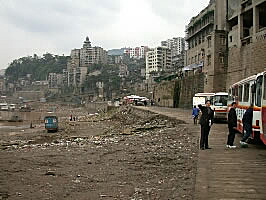 The
waiting buses
The
waiting buses |
|
|
|
|
|
|
|
|
|
|
|
|
|
|
|
| Take
a look at the rightmost picture above. I know it's difficult to see,
but you can just make out the water in the center left of the picture.
From the water to where the buses were parked there was at least a
fifty foot difference in elevation and the distance between the water
and the buses was strewn with litter and garbage. That distance was
the safety zone for when the Yangtze is running at its deeper levels
in the Spring. In many cities we observed steep steps from the water's
edge to the city. Some numbering in the hundreds. I know I, for one,wouldn't
have been happy if I had to climb them. I'd never have made it. |
|
|
|
|
|
|
|
|
|
|
|
|
|
|
|
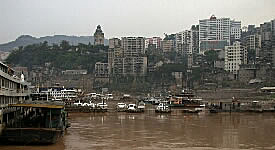 Wanxian
from the Princess Elaine
Wanxian
from the Princess Elaine |
Unfortunately
I don't have any pictures of the city as our tour was a quick bus
tour and it was virtually impossible to take any pictures from the
bus. It was interesting though. We saw many abandoned buildings scheduled
for demolition, whole streets where the residents had been moved to
higher ground. On one street they were removing all of the trees for
replanting at a higher elevation. This was remarkable. They cut almost
every limb off and the roots also, so what they were left with to
plant was just the main trunk of the tree. We don't see how the trees
could survive such trimming, but they obviously do since we saw them
planting the trees later on. |
|
|
|
|
|
|
|
|
|
|
|
|
|
|
|
| Our
first stop in Wanxian was at the local museum. There wasn't much there
with the exception of a hanging coffin. |
|
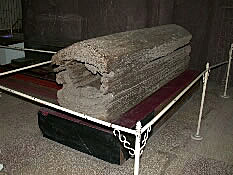 A
2,000 year-old hanging coffin
A
2,000 year-old hanging coffin
made from wood and petrified
over time |
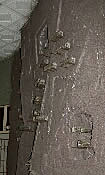 Model
of how
Model
of how
the coffins would
be hung along
the cliff |
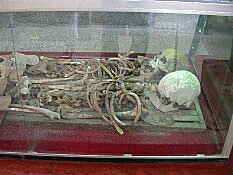 The
inhabitants of the hanging coffin.
The
inhabitants of the hanging coffin.
As it was explained to us, two people
were buried in the one coffin. The
second person was sacrificed |
|
|
|
|
|
|
|
|
|
|
|
|
|
|
|
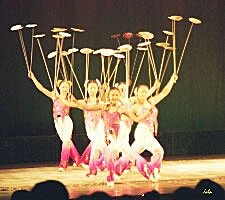 Acrobats
in training
Acrobats
in training |
From
the museum we headed to a theater to observe one of the smaller
training schools for the acrobats. In Shanghai we had observed the
professionals and, now, those in training. The Chinese take acrobatics
seriously and they are extremely good at it. While this wasn't as
spectacular as the five motorcycles in the steel cage, it was a
very good and enjoyable short presentation.
From
the school we headed over to the local market. The local markets
in China, as I've said before, are very exciting to visit and take
pictures. They're so different from what we are accustomed to that
they command your complete attention while strolling through them.
Enjoy the pictures from the local market.
|
|
|
|
|
|
|
|
|
|
|
|
|
|
|
|
|
|
The
bus dropped us off at the top of the street and we quickly made
our way past the tourist stalls
(left) and the dollar people to the vegetable, meat and flower market.
Above right, Mei helps Faye
with a purchase from one of the vendors.
|
|
|
|
|
|
|
|
|
|
|
|
|
|
|
|
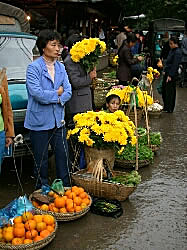 Beautiful
flowers and
Beautiful
flowers and
ripe oranges for sale |
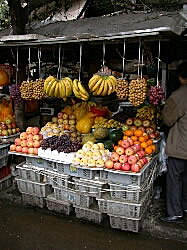 Some
known and exotic
Some
known and exotic
fruits for sale |
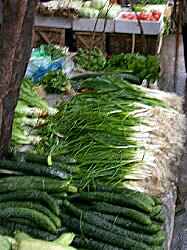 Fresh
green vegetables
Fresh
green vegetables |
|
|
|
|
|
|
|
|
|
|
|
|
|
|
|
|
|
|
|
|
It's
impossible to tell you what was in the pans above for sale. I wasn't
necessarily drawn to them
because they looked or smelled appetizing. I was drawn by the bright
colors and the patterns
they presented for pictures.
|
|
|
|
|
|
|
|
|
|
|
|
|
|
|
|
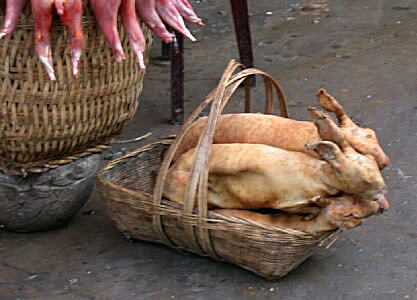 Anyone
like hare for dinner?
Anyone
like hare for dinner? |
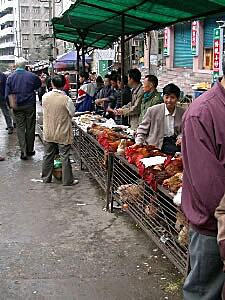 Live
chickens, ducks and rabbits
Live
chickens, ducks and rabbits |
|
|
|
|
|
|
|
|
|
|
|
|
|
|
|
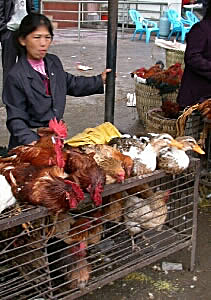 Live
chicken and ducks were
Live
chicken and ducks were
placed in plastic bags for
the walk back home |
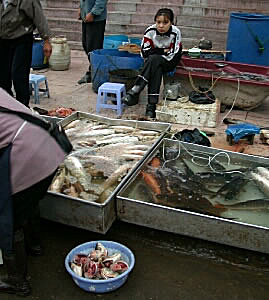 Fresh
fish
Fresh
fish |
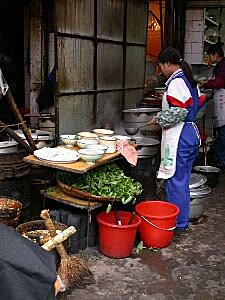 Sidewalk
cook
Sidewalk
cook |
|
|
|
|
|
|
|
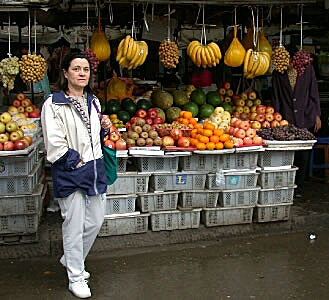 Anne
standing by the fruits. Many times we would
Anne
standing by the fruits. Many times we would
buy and try the fruits. As long as you can peel
them it was safe to eat them. |
| Our
allotted time to visit the market had come to an end. It was now time
to return to the bus and set sail on the Princess Elaine for Chongqing,
375 miles upriver from Wanxian. Join us on the next page for the last
pictures of the Yangtze and the few pictures we took in Chongqing
... |
|
|
|
|
|
|

